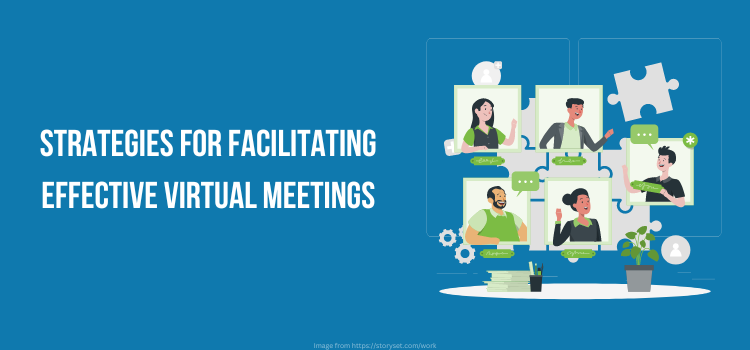Virtual meetings are now a standard way of conducting business, but simply convening does not guarantee a productive meeting. As we learned in our previous posts, proper planning that takes into account participants’ social needs is essential for a successful virtual meeting. However, planning alone is not enough to ensure that participants remain engaged throughout the meeting. In this post, we continue to incorporate the SCARF Model as we take a closer look at some strategies you can use to facilitate effective virtual meetings that foster engagement and encourage participation from all attendees. These strategies will help you make the most of your virtual meetings, ensuring that your time is well-spent and that participants feel valued and heard.
Just Before the Meeting Begins
Facilitators should log on to the meeting a few minutes early to test internet connection, camera and microphone functioning, and ensure any collaborative tools being used are working properly. Additionally, being early to the call creates an excellent opportunity to greet participants as they join the meeting. This simple step can help build relationships and set the tone for an engaged, participatory meeting.
During the Meeting
- Take Attendance and Make It Visible: Taking attendance may seem like a small detail, but it is an essential part of ensuring a participatory meeting. It is helpful to make the attendance list and agenda visible for participants so that everyone can track progress and who all is in attendance throughout the meeting.
- SCARF Domain: Status, Certainty
- Establish Norms and Make Them Visible: Establishing norms for participation is important to create a safe and collaborative space for all participants. Ideally, norms should be established by the group before any meetings take place, but if not, a few minutes should be allocated at the start of the meeting to set expectations for participation moving forward. It is helpful to make these norms visible throughout the meeting. This can be done by sharing them in the chat at the beginning of the meeting and by including them in the agenda.
- SCARF Domain: Certainty, Relatedness
- Ensure Everyone Has Necessary Documents or Information: Making sure that everyone has the necessary documents and information to participate in the meeting keeps everyone on the same page. Take a minute at the start of the meeting to check in with participants to see if they are missing anything that is needed to fully participate. This step helps to level the playing field by ensuring each participant has the information they need to engage in the meeting no matter if they’re new to the group or a long-time member.
- SCARF Domain: Certainty, Autonomy, Fairness
- Utilize Collaborative Tools: Using collaborative tools like Google Docs and Slides or virtual whiteboards can help make virtual meetings more interactive and participatory. These tools allow participants to collaborate in real-time, share their ideas, and work together towards common goals. These tools also reduce the reliance on verbal communication, making it easier for all participants to share their thoughts and follow along with the meeting. We’ve included examples at the end of this post.
- SCARF Domain: Autonomy, Relatedness, Fairness
- Create Opportunities to Participate: Creating opportunities to participate is an essential part of facilitating a participatory meeting. Utilizing collaborative tools is a great place to start. Opportunities to participate can also be created by allowing time for participants to read, think, or write before seeking responses. Doing so de-emphasizes verbal communication and levels the playing field between participants’ varying communication strengths and preferences. Additionally, it is helpful to reference the attendance list and make an effort to call on each person to garner participation.
- SCARF Domain: Autonomy, Relatedness, Fairness
- Minimize Screen Sharing: While screen sharing can be helpful for presenting information, it can also be a barrier to participation. When screen sharing, participants can become invisible to each other. This makes it even more challenging to read body language and facial expressions, and remember who all is in attendance. Minimizing screen sharing and keeping participants visible can help maintain engagement and participation.
- SCARF Domain: Status, Relatedness
- Honor Everyone’s Time: Respecting everyone’s time is essential for creating a participatory meeting. Follow time limits for discussions and tasks, and be mindful of everyone’s time constraints.
- SCARF Domain: Status, Fairness
- Note Follow Up Items and Designate Tasks: Taking notes and following up on tasks is crucial for ensuring that the meeting’s objectives are met. At the end of the meeting, make sure to note follow-up items and designate tasks as needed to keep the momentum going.
- SCARF Domain: Certainty, Relatedness
Virtual meetings have become a necessary part of our lives, and it’s essential to make them as participatory and engaging as possible. Incorporating these facilitation strategies can help ensure a successful meeting that works towards important goals and objectives while building strong, collaborative relationships. However, the work to create successful virtual meetings doesn’t end when the meeting ends. So far, we’ve covered how to plan and facilitate effective, engaging, participant-centered virtual meetings. Now it’s time to focus on what comes after the meeting. In our next post, we’ll cover strategies to ensure that momentum gained during the meeting is sustained, desired outcomes are achieved, and future meetings continue to be successful and fruitful for all involved.
Are you interested in learning more about how you can develop your facilitation skills? Join us in the New School of Participatory Change in our Participatory Facilitation course. In this online cohort experience, you’ll work with us to develop your own practical approach to facilitating participatory conversations, whether in front of a computer or in front of a room.
Click here to learn more about the New School and how we can help you become a better participatory facilitator and changemaker.

